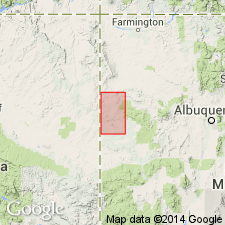
- Usage in publication:
-
- Dilco coal member*
- Modifications:
-
- Named
- Dominant lithology:
-
- Sandstone
- Shale
- Coal
- AAPG geologic province:
-
- San Juan basin
Summary:
Named as second member from base of five members of Mesaverde formation for town of Dilco, sec 22, T15N, R19W, Valencia Co, NM in San Juan basin. No type locality designated. Contains several coal beds, four of which have been worked in the Dilco mine. Consists of light-gray clay shale and light-gray to white lenticular sandstone with a shale[?] at base and the Dilco No. 1 coal bed at top. Ranges from 240 to 300 ft thick. Overlies Gallup sandstone member (new) of Mesaverde; underlies Bartlett barren member (new) of Mesaverde. Of Late Cretaceous age.
Source: GNU records (USGS DDS-6; Denver GNULEX).
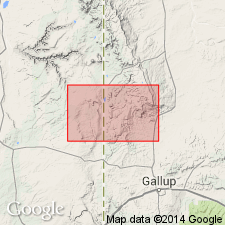
- Usage in publication:
-
- Dilco member
- Modifications:
-
- Revised
- AAPG geologic province:
-
- San Juan basin
Summary:
Upper Cretaceous Dilco member of Mesaverde formation reassigned to Crevasse Canyon formation (new) of Mesaverde group in Tohatchi quad, McKinley Co, NM in San Juan basin. Is basal member of Crevasse Canyon. Overlies Gallup sandstone and underlies Dalton sandstone member of Crevasse Canyon. Is a silty shale, laminated siltstone, thin coal and thin- to medium-bedded fine-grained sandstone 240 ft thick. Colors range from white through buff to gray and black. Is of Late Cretaceous age.
Source: GNU records (USGS DDS-6; Denver GNULEX).
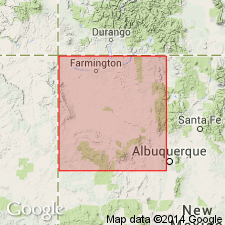
- Usage in publication:
-
- Dilco coal member*
- Modifications:
-
- Revised
- AAPG geologic province:
-
- San Juan basin
Summary:
Dilco coal member, formerly a member of Mesaverde formation, assigned to Crevasse Canyon formation as basal of four members. Crevasse Canyon is one of five formations assigned to Mesaverde group. Group is extended throughout San Juan basin of southwest CO and northwest NM. Dilco overlies Gallup sandstone; underlies and intertongues with Mulatto tongue of Mancos shale. Dilco pinches out in south-central part of San Juan basin. Small geologic map. Diagrammatic sketch map. Of Late Cretaceous age.
Source: GNU records (USGS DDS-6; Denver GNULEX).
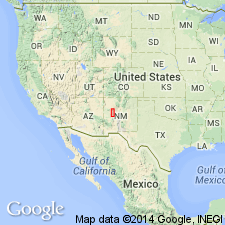
- Usage in publication:
-
- Dilco coal member*
- Modifications:
-
- Revised
- AAPG geologic province:
-
- Orogrande basin
Summary:
As a member of Crevasse Canyon formation of Mesaverde group overlies Gallego sandstone member of Gallup sandstone. Gallego is reassigned in this report, Socorro Co, NM in the Orogrande basin, from Miguel formation (abandoned in this report) to Gallup. Measured sections. Geologic map. Of Late Cretaceous age.
Source: GNU records (USGS DDS-6; Denver GNULEX).

- Usage in publication:
-
- Dilco Coal Member*
- Modifications:
-
- Biostratigraphic dating
- AAPG geologic province:
-
- San Juan basin
Summary:
Study of palynomorphs from samples of coals and shales of the Upper Cretaceous Crevasse Canyon Formation indicate a biostratigraphic age assignment of Coniacian and Santonian for the formation. Crevasse Canyon Formation, in the Hosta Butte area, McKinley Co, NM (San Juan basin), overlies Gallup Sandstone (Turonian) and is overlain by Hosta Tongue of the Point Lookout Sandstone (Santonian). Crevasse Canyon is separated into lower and upper parts by the Mulatto Tongue (Coniacian) of the Mancos Shale; lower part comprised of Dilco Coal Member (Coniacian) and upper part comprised of Dalton Sandstone Member (Coniacian) and Gibson Coal Member (Santonian). Turonian/Coniacian Stage boundary is queried at the Gallup/Dilco contact at base of Crevasse Canyon Formation. Coniacian/Santonian Stage boundary is queried at the Dalton/Gibson contact within the upper part of the Crevasse Canyon. Samples were examined from the Dilco and Gibson Members, but not the Dalton Member. Crevasse Canyon is tentatively divided into 3 pollen zones spanning the Coniacian and Santonian. The stage assignments are derived from invertebrate zone fossils found in the associated marine rocks. An uppermost Turonian ammonite is reported from near the top of the Gallup in the Gallup area. The Mulatto Tongue yields lower Coniacian INOCERAMUS DEFORMIS near Tohatchi. Thus the intervening Dilco is of Coniacian or possibly latest Turonian age.
Source: GNU records (USGS DDS-6; Denver GNULEX).
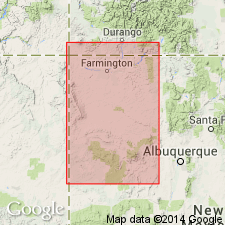
- Usage in publication:
-
- Dilco Member*
- Modifications:
-
- Redescribed
- AAPG geologic province:
-
- San Juan basin
Summary:
"Coal" designation removed from unit rank because coal is a minor part of unit and in many areas to east within San Juan basin, coal is entirely absent. Dilco is a lower member of Crevasse Canyon Formation (revised). Dilco shown in fig. 2 to overlie and surround Torrivio Sandstone Member (redescribed) now assigned to Crevasse Canyon. Late Cretaceous age.
Source: GNU records (USGS DDS-6; Denver GNULEX).
For more information, please contact Nancy Stamm, Geologic Names Committee Secretary.
Asterisk (*) indicates published by U.S. Geological Survey authors.
"No current usage" (†) implies that a name has been abandoned or has fallen into disuse. Former usage and, if known, replacement name given in parentheses ( ).
Slash (/) indicates name conflicts with nomenclatural guidelines (CSN, 1933; ACSN, 1961, 1970; NACSN, 1983, 2005, 2021). May be explained within brackets ([ ]).

